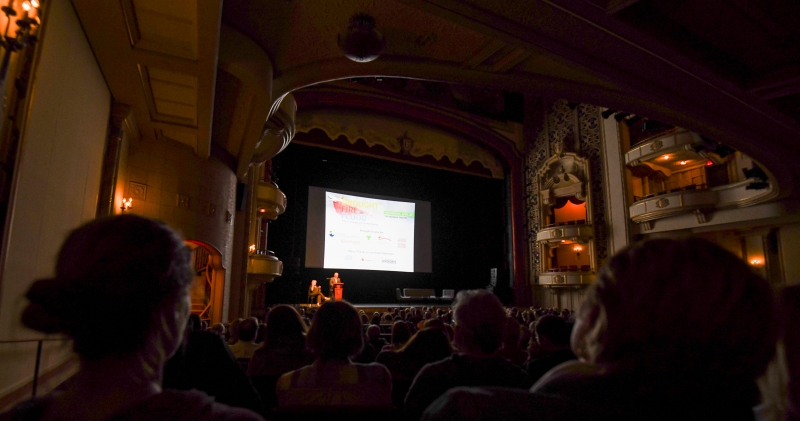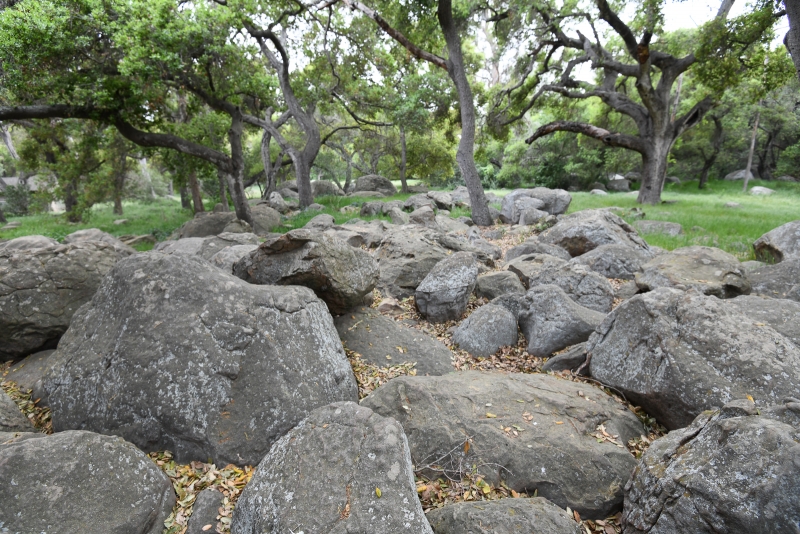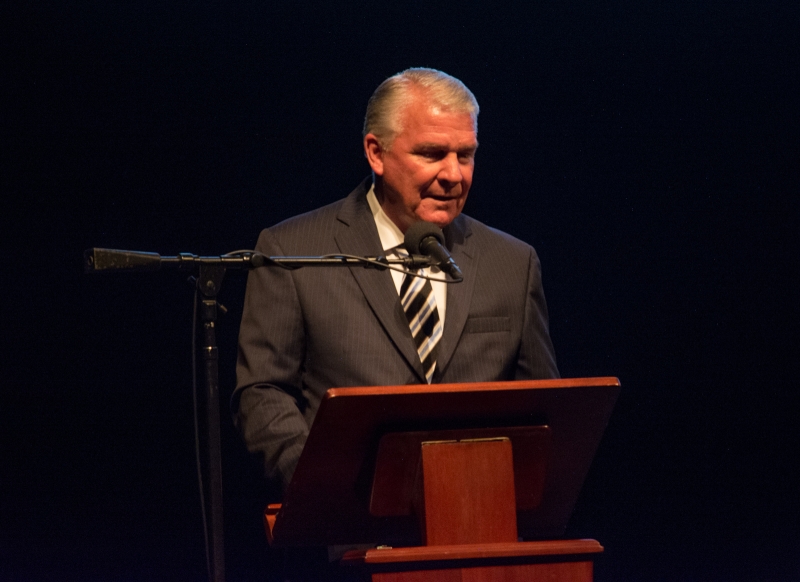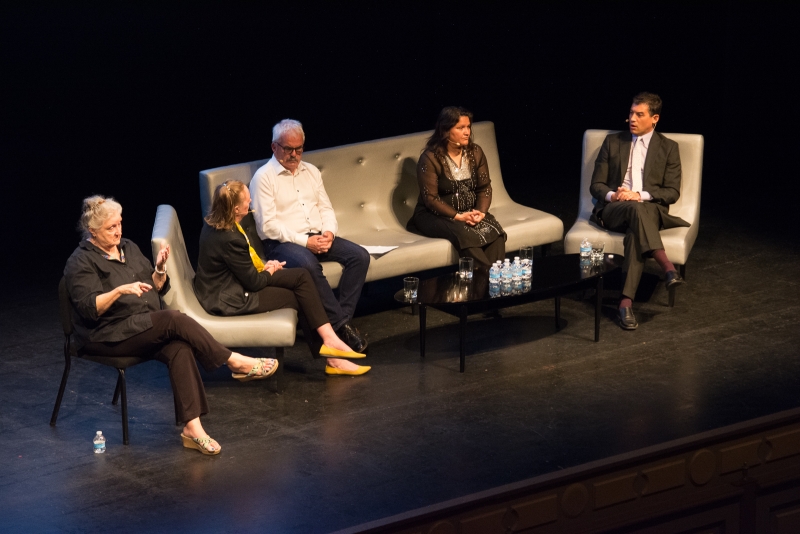Drought, Fire, and Flood: Climate Change and Our New Normal
“Science has taught me that everything is more complicated than we first assume.”
–Hope Jahren, Lab Girl
“Drought, Fire, and Flood: Climate Change and Our New Normal,” the community conversation held April 25 at the Granada Theatre (the space generously shared by the Santa Barbara Center for the Performing Arts), educated and motivated those who could devote their Wednesday evening to getting informed about local climate resilience. If you missed the event, read on for detailed coverage.
This event had its roots in the long drought and increasingly severe fires that scourged our state in recent years, which set the stage for devastating local flooding and debris flows in January. Following the death and destruction in Montecito, members of the SBMNH Board of Trustees suggested that the Museum host an event addressing the natural disasters. Museum President and CEO Luke Swetland reached out to Karl Hutterer, the Museum’s Director Emeritus, and Community Environmental Council (CEC) CEO/Executive Director Sigrid Wright. The CEC, a “think-and-do-tank,” has spent approximately the last half-century promoting solutions to environmental problems in the Santa Barbara area. In the last decade, it has specifically focused on promoting regional solutions to the challenges posed by climate change.
Swetland suggested the Museum and CEC work together, bringing in the Santa Barbara Foundation and the UCSB Bren School of Environmental Science and Management. Swetland asked Craig Springer—President and CEO of the Santa Barbara Center for the Performing Arts and Chrisman Executive Director of the Granada Theatre—about using the Granada as a venue. Everyone was enthusiastic about participating, Swetland reported: "It was dizzying how fast everyone asked said yes."
After the disaster, numerous events addressed the fire and debris flows very specifically. Some of those events were more focused on assigning blame, but the Museum and the CEC were interested in looking for solutions. “We wanted to share a different perspective,” said event organizer Stefanie Coleman. “Can we shift budgets around to have more forward-thinking planning, rather than disaster relief?”
The co-conveners programmed an evening of solution-oriented conversation among experts. The variety of perspectives shared—including those of first responders, scientists, and public servants—made for an evening of complexity and nuance. As the Dude would say, it’s “a very complicated case…a lotta ins, a lotta outs, lotta what-have-you’s.” Wright noted at the event that the co-conveners have considered hosting a day-long symposium as a sequel, which would provide more detailed information for people who want to learn more about how they can advocate for a better, smarter community recovery.

The event was introduced by Swetland and emceed by Steve Gaines, Dean of the Bren School. In his opening remarks, Gaines posed the question of the night: “How do we recover and rebuild in ways that make us more resilient to such disasters in the future?” He also stated what would become a recurring theme of the evening: that “smart investing now will be far less expensive than recovering again in the future.” As the old adage puts it, an ounce of prevention is worth a pound of cure.
Dr. Max Moritz—head of the Moritz Lab studying fire regimes and ecosystem management at UC Berkeley and a visiting professor at the Bren School—delivered the first of four brief talks by researchers. Moritz explained how a complex of three factors—wind, fuel availability, and humans as ignition sources—influence the course of wildfires. His data suggested that during the Thomas Fire, winds had a greater impact in the Ventura and Ojai areas, while fuel availability played a bigger role in the fire’s expansion near Santa Barbara. Lastly, because none of the three factors discussed are going away anytime soon, Moritz stressed the permanent role of fire in our landscape and the importance of learning to coexist with fire by building and planning for it as we would for other natural disasters, like earthquakes.
Those of us who expected an evening of doom and gloom were made to smile and even laugh by Ed Keller, Professor of Earth Science and Environmental Science at UCSB. He delivered good news: while the occurrence of another catastrophic debris flow in the near future is possible, it’s unlikely. He put our January nightmare in perspective with the mass movement of enormous boulders that occurred about a thousand years ago, bringing giant rocks from the area that is now Skofield Park down the watershed to put the “Rocky” in Rocky Nook Park.

Boulders from the old debris flow in Rocky Nook Park
Keller listed three easy-to-remember preconditions for very damaging debris flows. The first is accumulation of debris, which can take hundreds of years. The second is wildfires, which tend to happen every 30-50 years in a given area. The last precondition—the one that pulls the trigger on the disaster waiting to happen—is intense precipitation. The volume of available debris, the severity of the fire, and the intensity of the precipitation all affect the scale of the resulting flow. “After every fire we expect debris flows,” he said, but in our area they are usually small ones.
Keller and his colleagues are now busy quantifying January’s flow to learn more about how these three factors aligned and what we can expect in the future. Among other things, they’re out measuring boulders to help estimate the volume of the flow. They’re also examining seismic records, using the vibrations caused by rumbling boulders to see how the rainfall triggered waves of debris flowing through space over time.
In the end, like fire, debris flows are part of our landscape: “Montecito is built on past debris flows,” Keller explained, noting that the boulders which adorn its gardens are great for landscaping, but rarely provoke any questions from residents about how they got there. Though really big flows are rare events, those events—as we all now know—are serious enough that they should provoke both thought and action in the form of preparedness.
Prof. Naomi Tague, an eco-hydrologist at the Bren School, discussed the value of models to answer questions about future changes in our region based on past data. Will it be warmer? Yes. Will it be wetter? Maybe. Tague said that locally, the impacts of climate change on our fire and flood cycles will likely be noticeable, but moderate. Storm events could become about twice as likely, meaning that the very damaging storms we’re accustomed to seeing about once every 200 years could now come about once every 100 years. Rising sea levels could pose a more significant challenge for our coastal region.
Tague highlighted the fact that our home isn’t an island. The tri-counties will be affected by more dramatic changes occurring elsewhere in the state (not to mention the nation and the planet). Notably, with fire season beginning earlier and ending later throughout California, the resources we share will continue to be strained. This includes not only budgetary resources, but water, equipment, and people like first responders and civil servants involved in firefighting and disaster management.
This warning accentuated the relevance of the next talk, by Prof. Sarah Anderson, a political scientist (also from the Bren School) who studies how people and governments respond to disasters. Anderson provided useful advice for citizens seeking government funds to intelligently rebuild after disaster. First, take advantage of the moment, because governments tend to allocate more funds within a three-year window after the disaster. As time passes, the risk of a cyclical disaster’s recurrence rises, even as public awareness of the risk decreases, so you need to hit the sweet spot while it lasts. This is a good time to influence decision-makers to help people invest in retrofitting existing houses. It’s also time to ask them to make hard choices about planning and development, implementing land use changes for public safety that will be even less popular when memory of the disastrous event has faded.
Second, “talk about what did happen, not what might happen.” Anderson’s research shows that decision-makers pay more attention to events that have already taken place than to hypothetical events (presumably even if hypothetical events are projected to have worse consequences). Finally, mobilize voters early for the biggest impact on decision-makers, and enlist experts as time passes, to help keep up the momentum. Anderson’s was the last of the four pithy science talks, and felt like a natural conclusion to the segment of the program devoted to informing citizens to help us be part of the solution.
Now for something entirely different: keynote speaker James Lee Witt eased off on the statistics and offered up anecdotes from his tenure as the director of FEMA during the Clinton administration and his work since then as a private consultant in the disaster management field. He immediately set a change of pace from the 3-minute flash talks by warning the audience, “I don’t think I can accomplish this speech in three minutes with an Arkansas accent. I hope you can understand that.” If that remark doesn’t make you chuckle, then you had to be there.

After graciously thanking the first responders and the conveners of the event, Witt acknowledged the extreme nature of the winter’s events. “I know that you have been through a traumatic event,” he said gravely, pivoting to ask, “Are we going to continue down the same path that we have in the past?” He encouraged us to instead gather data from diverse sources, rebuild smarter, and help each other as a community.
Witt drew on his experiences to illustrate the importance of taking time to build right. Visiting an area leveled by the 1994 Northridge Earthquake, Witt described approaching the single house that remained standing in the neighborhood. Witt asked the homeowner, “What did you do?” The man explained that he had gone to the county library and checked out a video tape produced by FEMA and OES (the state agency Office of Emergency Services) about how to retrofit your home for earthquake protection. For about $1,000 (adjusted for inflation, that’s about $1,650 today) the homeowner made changes that saved his family hundreds of thousands of dollars.
This wasn’t an isolated incident: Witt told a similar story, dating from the 1993 Laguna Beach Fire, and stressed that this has been a recurring motif in his experience. Those who take time to invest in preparations according to government guidelines are better protected when disaster strikes. Of course, there’s no surprise here: policy that’s based on research works. The lesson isn’t that preparing is helpful, but that it requires deliberate effort that not everyone is willing to invest. Take it from those who have seen disaster up close: the investment is worth it. He praised California for investing in renewable energy, which he particularly lauded as a way to generate power locally when disruptions in the power grid cut off the flow of energy from afar.
Witt has also worked to build public-private partnerships that encourage disaster preparedness throughout a community, benefiting citizens and businesses alike. He took time to describe the special devastation disasters inflict on small businesses, which are more vulnerable to disaster than their larger counterparts, a message that undoubtedly struck home to many in the audience. To lighten the mood, he shared a tale about Al Gore filling sandbags in a ditch that’s worth hearing straight from the horse’s mouth. (TVSB filmed the evening, and if that becomes publicly available, we’ll link it here so you can hear the anecdote with the benefit of Witt’s aforementioned Arkansas accent and comic timing.)
“Climate change is real,” Witt said, prompting applause from the audience. “We’re going to see more devastation, and larger events than in the past.” His final words encouraged us to be worthy of the beautiful home we now enjoy, by investing in protecting the future. He quoted an Argentinian missionary he met at a theological school in Virginia: “If you don’t plant the seeds of the trees of the future, you don’t deserve to stand in the shade of the trees of the past.”
An evening that already included many perspectives wrapped up with a panel discussion that looped in community leaders who could discuss other social and environmental issues relevant to the recovery process. The discussion was moderated by Sigrid Wright.

Left to right: ASL interpreter Jo Black, Sigrid Wright, Pat McElroy, Maricela Morales, Das Williams
Recently retired Santa Barbara City Fire Chief Pat McElroy shared the concerns raised among firefighters in recent years, as more frequent and severe wildfire events have deviated from past trends once taken for granted. Recent development at the periphery of residential zones has chipped away land formerly suitable for staging equipment or building firebreaks, adding those once-useful spaces to the expansive areas firefighters already work to defend. “I’m weary of politicians saying, ‘I’m not a scientist,’” McElroy said, unimpressed with the trend among climate change deniers to use ignorance as a jumping-off point for their own analysis. “I’m not a scientist either, but I try to listen to scientists, and I try to listen to my own experience.” His experience has taught him that it’s a more dangerous world for firefighters today.
Maricela Morales, Executive Director of Central Coast Alliance for A Sustainable Economy (CAUSE) and—as Wright put it, a breaker of “many glass ceilings,” lent a perspective rooted in her work in social and environmental justice. She stressed that we should be concerned about climate change’s impacts on human life, and avoid viewing it as something that happens to our environment in a vacuum. Widespread research has shown that those impacts will disproportionately affect those who are already the most vulnerable: people in poverty, women, and people of color. “Not all people are protected equally” from the effects of disaster locally, either. Morales called our attention to how during the Thomas Fire many farmworkers worked outdoors, performing strenuous physical labor with inadequate protection on days when the air quality was so bad that even office employees were told to stay at home.
First District Supervisor Das Williams echoed those concerns, remarking that “this isn’t just a problem that affects endangered species,” but a question of how to “stave off the worst humanitarian disaster the world has ever known.” Citing the current chaos and political conflict induced by refugees from civil wars and conflict zones around the world, he asked—as many political scientists and climate researchers have asked before him—how global leaders will cope with the far greater numbers of refugees projected to be mobilized by the effects of climate change.
On a more local level, Supervisor Williams called back to Prof. Tague’s warning that Santa Barbara isn’t an island: “We are not an island, but we can quickly become one” in a negative sense, when the unique geography of our region turns against us after the simple closure of Highway 101. Williams noted how the disaster-triggered isolation that hit local businesses so hard this winter was compounded by the fact that the lack of affordable housing means we effectively “exile our young.” This carries an extra sting during disasters, because many first responders are young people who endure long commutes to afford rent.
Throughout the event, it was striking how while every speaker and panelist drew on a different background of expertise and experience, they echoed each other on many points. Several expressed hopes that the winter’s tragedy would energize local citizens to mobilize for change, as the 1969 oil spill did. Some expressed concern about whether the political will to rebuild for the better would survive the shortsighted pressures of political expediency and factionalism. Supervisor Williams noted that “even if we don’t [have the political will to overcome partisan politics] nationally, we do here.” Wright concluded the panel on that note: “The vision that we have, we can make it real.”





3 Comments
Post a CommentThank you for this excellent and well-written synopsis, Owen!
You're very welcome, Sabina!
This is a comprehensive look at the multifaceted issue of climate change and how it's impacting us at a local level. It's refreshing to see a solution-oriented approach rather than just placing blame. The point about "smart investing now will be far less expensive than recovering again in the future" is particularly poignant. It's crucial that we listen to experts in various fields—from first responders to scientists—to come up with effective strategies for resilience and preparedness. Thanks for sharing such an insightful piece.